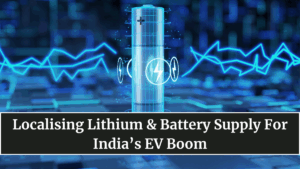As India accelerates toward an all-electric future, one challenge stands above all — securing its own energy backbone. The India lithium battery supply chain localisation movement is fast becoming the cornerstone of the nation’s EV revolution. With the country expected to become the world’s third-largest EV market by 2030, building a self-reliant supply chain for lithium, battery cells, and related materials is no longer optional — it’s a national priority.

Why India Needs a Localised Battery Ecosystem
Batteries form the heart of electric mobility, accounting for 30–40% of an EV’s total cost. Until now, India has relied heavily on imports of lithium-ion cells and raw materials from China, Korea, and Japan. This dependency not only makes costs unpredictable but also exposes manufacturers to global supply disruptions.
A localized supply chain ensures price stability, national security, and faster innovation. It also aligns with the government’s Atmanirbhar Bharat (self-reliant India) mission, encouraging local production across every stage — from raw material extraction to cell manufacturing and recycling.
India’s Key Lithium and Battery Projects
India has made remarkable progress in developing a domestic ecosystem for batteries. Several large-scale projects are underway across the country:
| Project | Location | Organization | Focus Area |
|---|---|---|---|
| Khanij Bidesh India Ltd (KABIL) | Global sourcing (Australia, Argentina) | Govt. consortium | Overseas lithium & cobalt mining rights |
| Ola Gigafactory | Krishnagiri, Tamil Nadu | Ola Electric | Li-ion cell production (20 GWh capacity) |
| Tata Agratas Energy Park | Gujarat | Tata Group | Advanced cell & battery module manufacturing |
| Amara Raja Giga Corridor | Telangana | Amara Raja Batteries | Energy storage & battery recycling hub |
| Reliance New Energy Limited | Jamnagar | Reliance Industries | Integrated battery materials & cell production |
Together, these projects are expected to produce over 150 GWh of battery capacity annually by 2030, reducing import dependency and creating thousands of high-tech jobs.
Government Policies Supporting Localisation
The Indian government has launched multiple initiatives to encourage local manufacturing of batteries and raw materials:
-
Production Linked Incentive (PLI) Scheme – ₹18,100 crore allocated to attract investments in advanced chemistry cell (ACC) manufacturing.
-
National Programme on Advanced Chemistry Cell (NPACC) – Supports domestic R&D in new battery chemistries.
-
FAME-II and EV manufacturing incentives – Encourage OEMs to source components locally.
-
Mining partnerships – Joint ventures in Bolivia, Argentina, and Australia to secure lithium reserves for long-term supply stability.
These policies have turned India into one of the most attractive destinations for global battery makers and investors.
Challenges in Localising Lithium Supply
Despite impressive progress, several hurdles remain in achieving full localisation. India currently lacks commercial lithium reserves in significant quantities. While small deposits have been identified in Jammu & Kashmir, Karnataka, and Rajasthan, they are yet to be fully developed.
Other challenges include:
-
High capital costs for setting up giga-scale factories.
-
Limited domestic expertise in lithium refining and cell chemistry.
-
Dependency on imported minerals such as nickel, cobalt, and manganese.
-
Environmental clearances and sustainability concerns in large-scale mining.
Solving these issues will require close collaboration between the government, private sector, and international partners.
The Future of India’s Battery Supply Chain
The next few years will be decisive for India’s EV ambitions. As domestic manufacturing scales up, India is expected to become a major global hub for battery exports, serving not only its auto industry but also the global demand for renewable storage systems.
Startups are innovating in solid-state batteries, sodium-ion cells, and recycling technologies to make production greener and more efficient. Simultaneously, infrastructure development around battery testing, logistics, and safety certification is ensuring long-term reliability.
By 2030, India’s battery ecosystem will likely evolve into a complete circular economy — mining, manufacturing, reusing, and recycling within its borders. This will not only secure energy independence but also position India as a leader in sustainable mobility innovation.
FAQs
Why is lithium supply chain localisation important for India?
It reduces import dependency, stabilizes costs, and strengthens India’s EV manufacturing ecosystem for long-term growth.
Where is lithium found in India?
Exploratory reserves have been identified in Jammu & Kashmir, Rajasthan, and Karnataka, though large-scale mining is still under development.
What are India’s major battery manufacturing projects?
Key projects include Ola Electric’s Gigafactory, Tata Agratas Energy Park, and Amara Raja’s Giga Corridor.
How is the government supporting localisation?
Through PLI schemes, global mining partnerships, and R&D incentives for advanced chemistry cell manufacturing.
What is India’s EV battery target by 2030?
India aims to achieve over 150 GWh of annual battery capacity, supporting millions of electric vehicles and renewable storage systems.
Click here to know more.
